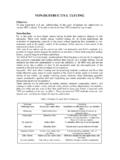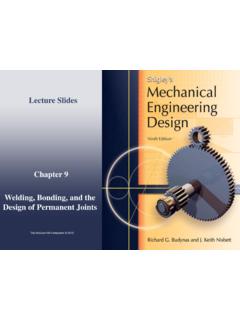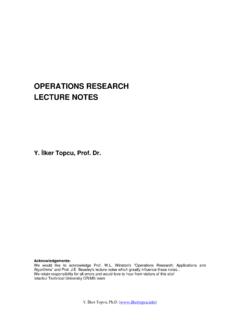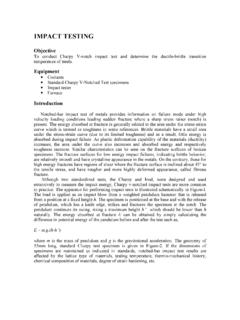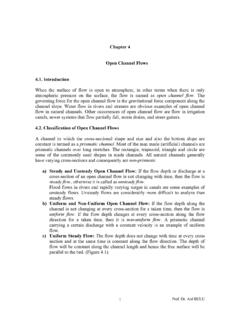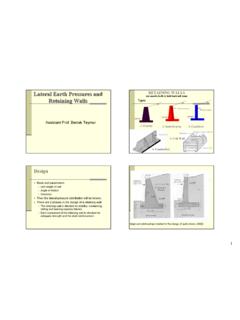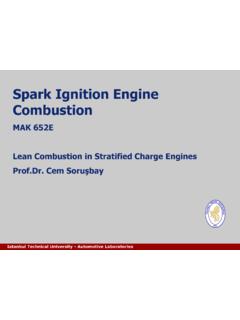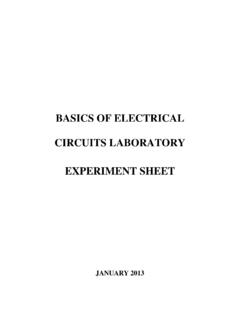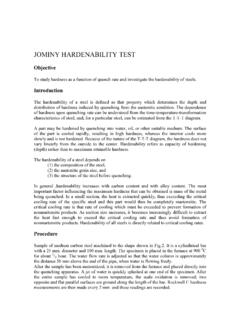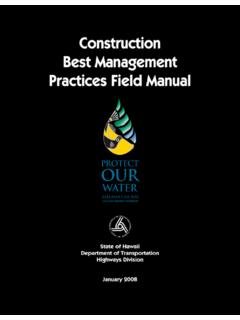Transcription of WEAVING TECHNOLOGY II - İTÜ
1 WEAVING TECHNOLOGY Emel mer Berk BerkalpTEK332E WEAVING TECHNOLOGY II Prof. Dr. Emel nder/ Assoc. Dr. mer Berkalp2 IntroductionIntroduction Fabrics are textile surfaces. These structures are extremely long in comparison with their thickness. There are basically 3 methods in fabric manufacture: 1. Weaving2. Knitting3. Nonwoven fabric manufacture (felt making) The yarn is used to produce fabrics by either WEAVING or knitting. An alternative method of producing a fabric from fibers, withoutmaking a yarn is that of felt making. Fabrics can be produced by one of those methodsor by a combination of them. TEK332E WEAVING TECHNOLOGY II Prof. Dr. Emel nder/ Assoc.
2 Dr. mer Berkalp3 Samples for different fabric structuresHandbook of WeavingSabit AdanurTEK332E WEAVING TECHNOLOGY II Prof. Dr. Emel nder/ Assoc. Dr. mer Berkalp4 EndEnd--use Fields of Woven Fabricsuse Fields of Woven Fabrics WEAVING and knitting are the two most common processes of makingcloth. Of these two processes, WEAVING is the most common method, although new and improved knitting machines make cloth quickly, satisfactorily, and with attractive patterns. The majority of the fabric production is based on the woven fabrics. Woven fabrics are manufactured for many end-use purposes:1. apparel fabrics for clothing/garmenting, , suits, dresses, shirts, coats, sportswear etc.
3 2. household textiles & furnishings, , curtains, tablecloths, bed sheets, towels, upholstery and tapestry fabrics, carpets, etc., 3. industrial and technical fabrics, , transmission belts, safety belts, sail cloths, sack cloth, tent cloth, geotextiles for WEAVING TECHNOLOGY II Prof. Dr. Emel nder/ Assoc. Dr. mer Berkalp5 TEK332E WEAVING TECHNOLOGY II Prof. Dr. Emel nder/ Assoc. Dr. mer Berkalp6 TEK332E WEAVING TECHNOLOGY II Prof. Dr. Emel nder/ Assoc. Dr. mer Berkalp7 WEAVING and Woven FabricsWeaving and Woven Fabrics WEAVING is the process of interlacing two sets of yarns at right angles. The threads which lie along the length of the fabric are termed warp threads, while those which lie across the width are termed weftthreads.
4 More technical names for these same threads are endsand picksrespectively. Weft threads are frequently referred to as EndsDCPicksBA1234 Warp RiserWarp SinkerTEK332E WEAVING TECHNOLOGY II Prof. Dr. Emel nder/ Assoc. Dr. mer Berkalp8 WEAVING and Woven FabricsWeaving and Woven Fabrics The WEAVING or interlacing of warp and weft threads is accomplished with a machine which is known the world over as loom. The loom may be a hand loomor a power loom. The power loom is also referred to as the WEAVING WEAVING TECHNOLOGY II Prof. Dr. Emel nder/ Assoc. Dr. mer Berkalp9 All woven cloth is made on some sort of loom. For most of the production, power looms have replaced hand looms, taking WEAVING from the home to the WEAVING TECHNOLOGY II Prof.
5 Dr. Emel nder/ Assoc. Dr. mer Berkalp10 Fabric PropertiesChemical PropertiesPhysical PropertiesAppearanceStructural Properties (Fabric Parameters)Mechanical PropertiesSensoryPropertiesPermeability & Insulation PropertiesTEK332E WEAVING TECHNOLOGY II Prof. Dr. Emel nder/ Assoc. Dr. mer Berkalp11 Chemical Properties Chemical properties are highly correlated with the fiber properties. Composition of fiber, Chemical stability, The effect of heat, moisture, acids, alkalis, solvents and other chemicals on fibers, The affinity of the fiber for dyestuffs, Moisture holding ability, Burning behavior, WEAVING TECHNOLOGY II Prof. Dr. Emel nder/ Assoc. Dr. mer Berkalp12 Structural Properties Fabric Parameters1.
6 Warp and weft densities2. Warp and weft yarn counts3. Weave4. Crimp5. Weight6. Thickness7. Cover8. Fabric width and piece lengthTEK332E WEAVING TECHNOLOGY II Prof. Dr. Emel nder/ Assoc. Dr. mer Berkalp13 Warp and Weft Densities Warp density Number of warp ends per unit length of fabric - spacing between warp threads; Units: ends per cm ( ) or ends per inch ( ); Determined by reed number and denting Weft density Number of picks per unit length of fabric - spacing between weft threads Units: picks per cm ( ) or picks per inch ( ); Determined by the rate of fabric take up during WEAVING . Count of Cloth End Density X Pick Density ( X is not multiplication sign)TEK332E WEAVING TECHNOLOGY II Prof.
7 Dr. Emel nder/ Assoc. Dr. mer Berkalp14 Count of Cloth The closeness or looseness of the weave is measured by the count of the cloth. This is determined by the number of picks and ends (filling and warps) to the square inch. If the count of the cloth is 80 warps (ends) and 80 fillings (picks) to the inch, the count is expressed as 80 x 80, or 80 square. If there are 60 warps and 50 fillings to the inch, the count is expressed as 60 x 50 Number of picks per unit length of fabric - spacing between weft threads. The count of surgical gauze is approximately 28 x 24. In comparison of the two counts, a 96 x 88 cloth is considered the higher-count cloth because it has more ends and picks (warps and fillings) to the square inch than has surgical WEAVING TECHNOLOGY II Prof.
8 Dr. Emel nder/ Assoc. Dr. mer Berkalp15 Balance of Cloth The proportion of warp yarns to filling yarns (picks) is called the balance of a cloth. If the number of warps and the number of fillings to the inch are nearly the same (not more than ten yarns difference), a cloth is said to have good balance. The gingham ( a stripe cotton cloth) whose count is 60 x 50 would be considered a fair-balanced cloth. Gauze with a count of 28 x 24 also has a good balance. A sheeting with 61 warp ends and 40 picks (61 x 40) has poor balance because there are too many ends and too few picks. Even though the sheeting is woven in the plain weave, ordinarily a strong construction, there are so few picks that the ends will slip over them very easily, causing a shredded effect.
9 Good balance is very important in cloths that have to stand hard wear and many washings. Sheets, pillow slips, and towels for glasses and dishes, for instance, should have good balance. TEK332E WEAVING TECHNOLOGY II Prof. Dr. Emel nder/ Assoc. Dr. mer Berkalp16 Yarn Count (Fineness or coarseness of yarns)It is very difficult to determine the yarn diameter by a direct measurement and it is more common to express the coarseness of the yarn in terms of its weight per unit length, hence in terms of the yarn count. 1 Nm = 1,693 Ne = (1000/tex) = (9000/denier)English Units1 inch=2,54 cm ; 1 yard=0,91 m1 libre(pound)=0,453 kg ; 1 ons=28,34 gTEK332E WEAVING TECHNOLOGY II Prof.
10 Dr. Emel nder/ Assoc. Dr. mer Berkalp17 Weave The fabric weaveor design is the manner in which the warp and weft threads are interlaced. In practice, the weaves of most fabrics are designed in a such way that the weave patternof a small area is repeated over the whole area of the fabric. The weave pattern within the small area, called the weave repeat, is usually referred to as weave. Simple weaves with small repeats are by far the most common. There are important differences between these three basic weaves, namely, plain weave, twilland WEAVING TECHNOLOGY II Prof. Dr. Emel nder/ Assoc. Dr. mer Berkalp18 Fabric Parameters: WeaveTWILL WEAVEWarp FloatFlat View of 2X2 WeaveWeft (Filling) FloatPLAIN WEAVEP icksWarpsSATIN & SATEEN WEAVES TEK332E WEAVING TECHNOLOGY II Prof.
